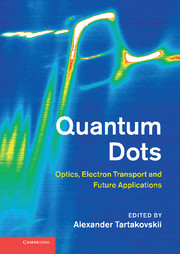Book contents
- Frontmatter
- Contents
- List of contributors
- Preface
- Part I Nanostructure design and structural properties of epitaxially grown quantum dots and nanowires
- Part II Manipulation of individual quantum states in quantum dots using optical techniques
- Part III Optical properties of quantum dots in photonic cavities and plasmon-coupled dots
- 8 Deterministic light–matter coupling with single quantum dots
- 9 Quantum dots in photonic crystal cavities
- 10 Photon statistics in quantum dot micropillar emission
- 11 Nanoplasmonics with colloidal quantum dots
- Part IV Quantum dot nano-laboratory: magnetic ions and nuclear spins in a dot
- Part V Electron transport in quantum dots fabricated by lithographic techniques from III–V semiconductors and graphene
- Part VI Single dots for future telecommunications applications
- Index
- References
8 - Deterministic light–matter coupling with single quantum dots
from Part III - Optical properties of quantum dots in photonic cavities and plasmon-coupled dots
Published online by Cambridge University Press: 05 August 2012
- Frontmatter
- Contents
- List of contributors
- Preface
- Part I Nanostructure design and structural properties of epitaxially grown quantum dots and nanowires
- Part II Manipulation of individual quantum states in quantum dots using optical techniques
- Part III Optical properties of quantum dots in photonic cavities and plasmon-coupled dots
- 8 Deterministic light–matter coupling with single quantum dots
- 9 Quantum dots in photonic crystal cavities
- 10 Photon statistics in quantum dot micropillar emission
- 11 Nanoplasmonics with colloidal quantum dots
- Part IV Quantum dot nano-laboratory: magnetic ions and nuclear spins in a dot
- Part V Electron transport in quantum dots fabricated by lithographic techniques from III–V semiconductors and graphene
- Part VI Single dots for future telecommunications applications
- Index
- References
Summary
In 1946, E. M. Purcell predicted that the radiative lifetime of an emitter is not an intrinsic property but can be modified by structuring the surrounding electromagnetic field [36]. By inserting a semiconductor quantum dot (QD) in an optical cavity, one can accelerate or inhibit its spontaneous emission. In the present article, we show that the QD spontaneous emission can be deterministically controlled to fabricate bright sources of quantum light.
QDs in cavities: basics, motivation, first demonstrations
Light-matter coupling
We note f the ground state of the QD and e its excited state. For a cavity mode close to resonance with the QD optical transition, we consider only the states with 0 or 1 photon in the cavity mode. The states ∣e, 0〉 and ∣ f, 1〉 are coupled through light–matter interaction, with a constant g, where hg = ∣〈e, 0∣ Ed∣ f, 1∣, with d the dipole of the optical transition e → f and E the electric field at the QD position.
Each of the states ∣e, 0 > and ∣ f, 1 > are also coupled to continua of states: continuum of the free-space optical mode, phonons of the semiconductor matrix, etc. [4]. Here, we consider only the coupling to the continuum of the free-space optical mode, related to the cavity losses, with a constant γc. When g << γc, the photon emitted by the recombination of an exciton efficiently escapes outside the cavity. The QD optical transition radiative recombination rate can be accelerated (Purcell effect) or inhibited.
- Type
- Chapter
- Information
- Quantum DotsOptics, Electron Transport and Future Applications, pp. 137 - 152Publisher: Cambridge University PressPrint publication year: 2012
References
- 1
- Cited by

